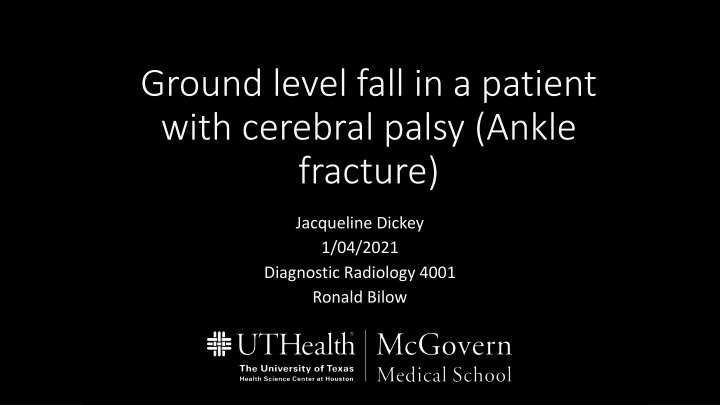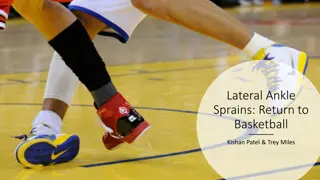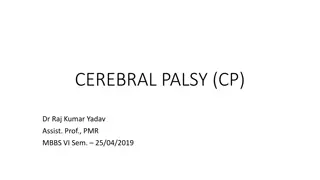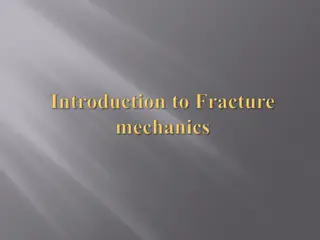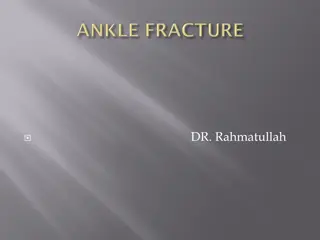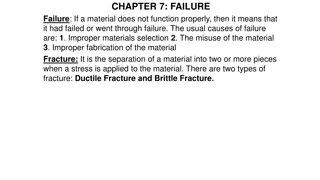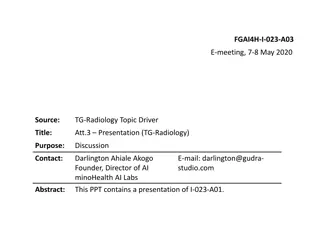Ankle Fracture in a Patient with Cerebral Palsy: Diagnostic Radiology Case Study
A 57-year-old male with a history of cerebral palsy presented with ankle pain following a ground level fall. Examination revealed a Danis-Weber type B3 fracture subluxation and a displaced age-indeterminant fracture of the talar neck with midfoot collapse. Key imaging findings included soft tissue swelling and deformity. The patient's motor and sensory functions were affected, requiring further evaluation and management for the ankle injury.
Download Presentation

Please find below an Image/Link to download the presentation.
The content on the website is provided AS IS for your information and personal use only. It may not be sold, licensed, or shared on other websites without obtaining consent from the author.If you encounter any issues during the download, it is possible that the publisher has removed the file from their server.
You are allowed to download the files provided on this website for personal or commercial use, subject to the condition that they are used lawfully. All files are the property of their respective owners.
The content on the website is provided AS IS for your information and personal use only. It may not be sold, licensed, or shared on other websites without obtaining consent from the author.
E N D
Presentation Transcript
Ground level fall in a patient with cerebral palsy (Ankle fracture) Jacqueline Dickey 1/04/2021 Diagnostic Radiology 4001 Ronald Bilow
Clinical History 57 y.o. M with PMH of cerebral palsy, HTN presents after awkward trip and ground level fall. Pt is ambulatory without assistance at baseline CBC, CMP wnl Associated R ankle pain with decreased ROM RLE exam: Obvious deformity to right ankle with foot in external rotation/eversion Foot rigid to attempted manipulation Motor: 0/5 big toe extension/flexion, 3/5 gastric/TA 2/2 pain, 5/5 hip/knee Sensation, vascular, and ligamentous knee exam all in tact
X-ray right ankle - 12/31 -s/p splinting of fibular Danis-Weber type B3 fracture subluxation http://www.wikiradiography.com/page/Ankle+Radiographic+Anatomy
X-ray foot - 12/31 -Displaced age indeterminant fracture of the talar neck with associated disruption of anterior subtalar joint with age indeterminant midfoot collapse https://www.google.co.uk/search?tbm=isch&tbs=rimg:Cc9yMWP0c15KIjgkNSHmKK3tthE9zhKWbX7mAOW3Hgn-0ZrfNvoHPt5slXKA-wFwG5Bm-vmnyHDHuDk2X- iUTcs0MyoSCSQ1IeYore22EWZ9uaIpmYPaKhIJET3OEpZtfuYRJv0_1AVdbSx0qEgkA5bceCf7RmhG3BBS2YFPahyoSCd82-gc-3myVEfXH5s4FhIcoKhIJcoD7AXAbkGYREG2ZHrQu7d8qEgn6- afIcMe4ORGOTDCXyrlJ4ioSCTZf6JRNyzQzEaCDANqwysA4&q=anatomy%20musculoskeletal%20x%20ray&imgdii=cRqAD5D1rnrOmM:;cRqAD5D1rnrOmM:;yp64MkXB_DvKVM:&imgrc=cRqAD5D1rn rOmM:&cad=h#imgrc=RmnqY_0N4_qz_M:
Key imaging findings Danis-Weber type B3 fracture subluxation Displaced age indeterminant fracture of the talar neck with associated disruption of anterior subtalar joint with age indeterminant midfoot collapse Soft tissue swelling about ankle and dorsal aspect of foot
Danis-Weber Classification Weber B subclassificantions: B1: isolated B2: associated with a medial lesion (malleolus or ligament) B3: associated with a medial lesion and fracture of posterolateral tibia https://faculty.washington.edu/jeff8rob/trauma-radiology-reference-resource/11-lower-extremity/danis-weber-classification-of-ankle-fractures/ https://en.wikipedia.org/wiki/Danis%E2%80%93Weber_classification https://radiopaedia.org/articles/weber-classification-of-ankle-fractures?lang=us
Differential Diagnosis Ankle fracture Soft tissue injury Acute compartment syndrome Foot fracture Ankle sprain Tendon injury
Discussion- Mechanism of injury Closed reduction performed in the ED, placed in splint Post-reduction films show acceptable alignment https://radiologyassistant.nl/musculoskeletal/ankle/weber-and-lauge-hansen-classification
Posterior malleolus fracture Rare isolated posterior malleolus fractures = 1% of ankle fractures Trimalleolar fracture occurs more frequently (medial, lateral, and posterior malleolar fracture) or bimalleolar Often associated with ligament damage CT scan most useful imaging More difficult to treat (reduction and fixation) Surgery indicated if ankle instability present Plates and screws for stability https://www.orthobullets.com/trauma/1047/ankle-fractures https://radiopaedia.org/cases/posterior-malleolus-fracture
Medial/lateral malleolus fracture Lateral malleolar fracture is fracture of the fibula Medial malleolar fracture is fracture in tibia May occur with fibular fractures (lateral malleolus), aka bimalleolar fracture May occur with posterior tibial fractures (posterior malleolus) May occur with injury to ankle ligaments Lateral malleolar fracture Medial malleolar fracture https://radiopaedia.org/cases/lateral-malleolar-fracture https://radiologyassistant.nl/musculoskeletal/ankle/weber-and-lauge-hansen-classification
Discussion- Treatment Joint stability If bone/ligament ring of stability in ankle is broken at one site, joint remains stable If ring of stability is broken in more than one site, it becomes unstable Joint instability SURGERY Assess stability with abduction/external rotation force Stress test is used during imaging to determine whether joint is stable Laxity indicates instability ankle is either displaced or easily displaced with stress *Weber B is most likely to become unstable compared to Weber A or Weber C fractures https://www.ncbi.nlm.nih.gov/pmc/articles/PMC5994620/#:~:text=The%20ankle%20joint%20can%20be,two%20columns%3A%20lateral%20and%20medial. https://www.physio-pedia.com/Stress_tests_for_Ankle_ligaments https://www.massgeneral.org/orthopaedics/foot-ankle/conditions-and-treatments/ankle-fractures-unstable
Final Diagnosis Danis-Weber type B3 fracture subluxation Displaced fracture of talar neck associated with disruption of the anterior subtalar joint and midfoot collapse. Both age-indeterminant
ACR appropriateness Criteria $180 with insurance $449 without insurance https://nhhealthcost.nh.gov/costs/medical/result/x-ray-ankle-outpatient?carrier=uninsured
Take Home Points / Teaching points Danis-Weber scale is useful for prognosis. Weber B most commonly causes joint instability Mechanism of injury gives clues to diagnosis, so a thorough H&P is important Non-weight bearing and ankle deformities require further assessment Posterior malleolar fractures are rare and commonly occur with medial and/or lateral malleolus fractures Can use cortical lines and shape of bones to help determine age of fracture
